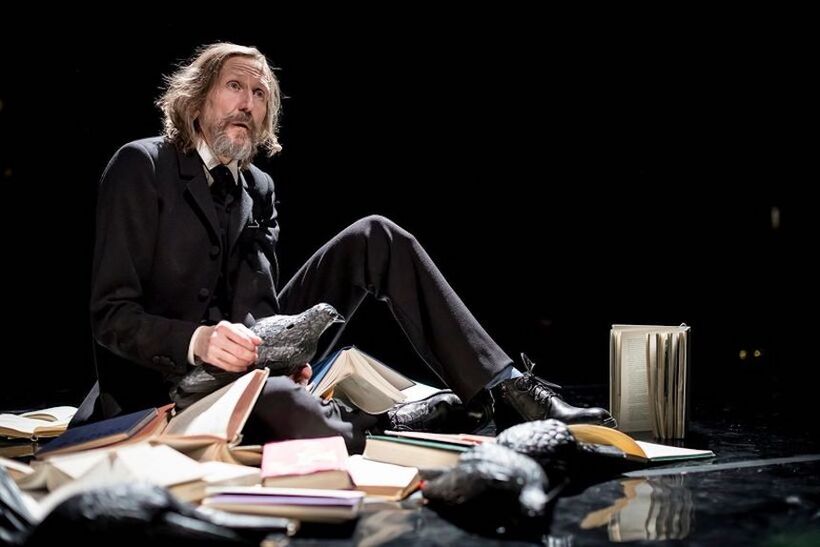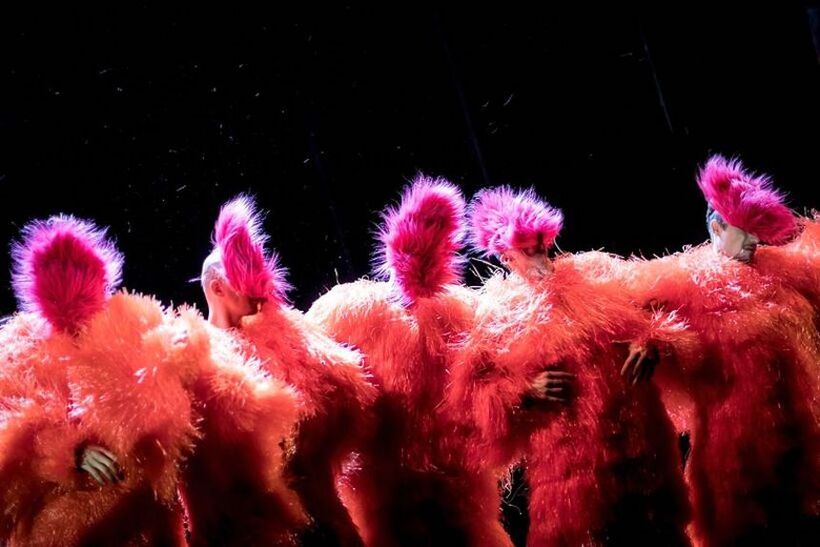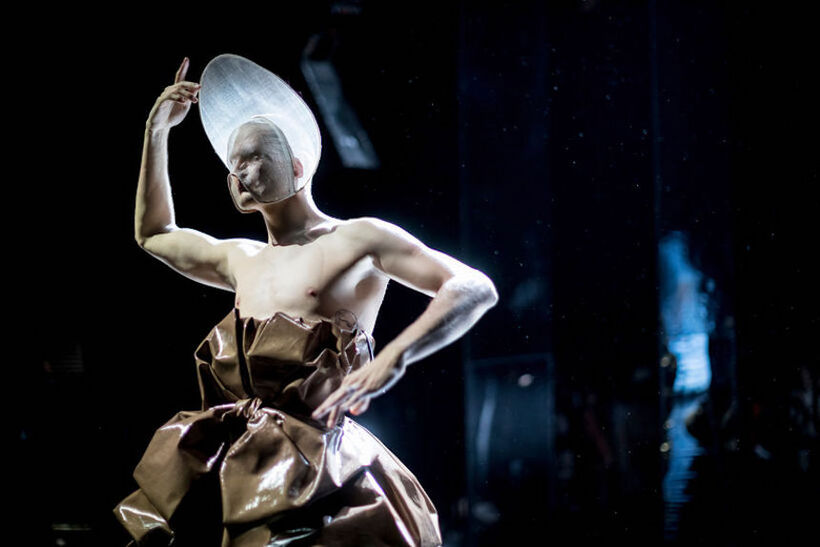Poe – Fear, Madness and Nightmares
A new piece – Poe – has been added to the repertoire of Laterna magika. It raised expectations because of its author: Lenka Vagnerová, a respected choreographer and director with an unmistakable style. With her own company, she has realized several productions in which she has worked on various themes that benefit from reflection on human existence. She likes to use unusual materials that illustrate movement and evoke further associations with the subject matter.
She has also used her talents in this new production inspired by the work of Edgar Allan Poe, the American poet and novelist, author of mystical stories and founder of the detective and horror genre. Vagnerová has worked her way through Poe's rich literary legacy to create a series of images in which dance, singing, words and music intertwine. In the programme, she states that she saw the beauty of the texts as one of the means of expression. Stepping back from the writer's troubled peripeteia, she let herself be carried away by the flow of thoughts and emotions of the selected works, in which the writer's addiction to alcohol and drugs was strongly imprinted in the form of rich descriptions of a torn mind and nightmares. There is a lot of text in the hour-and-three-quarters-long production, but the titles of the works used can only be guessed from the declamation or stage objects themselves. The program booklet does not indicate the source of the quotations used, so it is up to you to decide whether you have the reason and inclination to look them up on your own. I regard this information as essential and see no reason not to include it in the programme (its scant contents are indeed translated into English, but the texts forming an essential component of the performance do not appear in the translated captions above the stage, which therefore does not make it easier for foreign audiences to understand). Writing down of the selected titles would contribute to greater clarity in the order and content of the individual scenes, where it is possible to identify with certainty a well-known saying from the poem The Raven, an object associated with the short story The Pit and the Pendulum, or the colour of a dress associated with The Masque of the Red Death.
The madness of memory
The huge pendulum whizzes over the stage and the performers several times and remains suspended on the right or left side of the stage. The visual framing, evoking a dark dungeon in which a sharpened blade threatens to slice through, also refers to the poem. The playing area is bordered by dark columns, the lower part of which is transparent. In these translucent boxes we gradually see all the performers - actor Vladimír Javorský, Tereza Marečková embodying the literary man and dancers illustrating parts of the quoted works.
Javorský emerges from a pile of discarded books with artificial ravens and recites. The darkness of the scene is oppressive, the white, sharp lighting of the edges of the columns adds to the sepulchral, almost horror-like atmosphere. A dancer lies motionless on the ground, his hands imitating the beating of his heart, whose regular beat is reflected in the subsequent waves of his arms and entire body. It is a relatively long sequence with a uniform dynamic that gains or loses momentum in the following scenes.
The dancers come on stage in black pantsuits, white fiches at the neckline of their jackets, and later on their heads - they are a tight, determined army with a distinctive gesture. At other times they are roller-skating, giving the impression of dangerous monsters who won't move an eyebrow. What stands out in the kaleidoscope of images is Patrik Čermák's solo, whose movement runs through his body like electric shocks, unexpected but 100% controlled. Ondřej Vinklát also gets his opportunity to shine, impersonating the condemned man from The Pit and the Pendulum, prince Prospero from The Masque of the Red Death, the “dwarf man” from the horror story Hop-Frog, which Poe based on a real event, the Fireflies Ball of 1393 (at that time, during the ball, the disguises of King Charles VI of France and his five friends, masked as “wild men”, were set ablaze).
That is why a crazy masquerade of masks appears in the background of the stage or dancers disfigured with foam costumes parade in the foreground. If you do your research, you'll find that the prancing dancers in jumpsuits made of fabric with orange fringe, with masks on their faces, are the orangutans from the short story Hop-Frog. Some of the acts are said to reference humorous Poe stories, and at these moments the bright colours of the extravagant costumes and disguises are mixed into the black and white scenery. Here, Vagnerová has attempted buffoonery, with the dancer's head represented by a ball in his crotch, creating bizarre physical connections. However, the expected laughter is hardly elicited by the comic performances, which teeter more on the edge of awkwardness. The banter mostly misses the point, and the situation is not improved by shooting the performers with a camera from above, where in real life they are feet on the ground, but on the projection screen they are up and down (a trick already used by the successful 2017 production of Cube).
Mobile bugs
The involvement of media here works only as a necessary supplement (expected from Laterna magika), but the production could easily do without it - the winking eye on the screen is not enough to make us believe that the use of technological gadgets is something special here when the illusory connection between film and stage action does not occur. As time passes, the production runs out of breath. The mesmerising effect of kinetic delights, such as we are used to enjoy within Lenka Vagnerová’s work, is not to be expected. One cannot rely on the so-called Pepper's Ghoust Effect, where the reflection of large angel wings washes over the entire breadth of the theatrical scene.
The recited texts do not have a convincing enough stage form and the announced technical magic and scenic design by Eva Jiřikovská and Ivan Acher cannot save the embarrassing result. Nor do the scarabs riding around (I hope I am not mistaken that this is a reference to the adventure story The Gold-Bug). The mobile insect is only a fleeting reminder of one of the works, and the choreographer makes no attempt to capture the story itself or its interpretation. The black birds with which the dancers peck each other are related to the poem The Raven, to which is attached the repeated “Nevermore” by Javorský over a pile of books. Even in this case Vagnerová does not go into the deeper layers of the Poe's poeticism, she does not deal with the death of a girl connected with beauty, the theme of Raven, which fatally influenced the work of Charles Baudelaire, the representative of the Decadence movement (in connection with Poe he wrote: “From everything I have read, I am convinced that the United States was the one great prison for Poe, and that his inner, spiritual world as a poet or even as a drinker was his only persistent effort to escape the influence of this abominable atmosphere”).
The friable yarn of dramaturgy
Poe suffered from depression, anxiety and nightmares, and he described these states of madness opulently and savagely. Lenka Vagnerová has transformed his world full of phantoms, fear, and madness into a hardly comprehensible jumble of stage images, her hand guided not only by the legacy of the famous writer, but also by the musical score by Ivan Acher. Poe was a great challenge for him, one of the greatest he said he had ever experienced. The instrumentation of the music recorded in the studio consists of variously prepared pianos, cellos, violins, and, as the composer goes on to note, the blanks of large drums and brass clusters, as well as the solo articulations of these instruments. In several images, music and additional sounds and noises are mixed on the spot, and musical accompaniment is also provided by the singing Tereza Marečková, reincarnated in the younger version of the poet.
As I have already mentioned, from the group of nine dancers the excellent Ondřej Vinklát and Patrik Čermák get more space, the dancers Fanny Barrouquère, Zuzana Herényiová, Tereza Kučerová, Monika Částková are included in the chorus scenes, but they do not get the opportunity to express themselves more. If Vagner's previous works, built with her own LV&C ensemble, exude a very intense charge, building on physically attacking, almost animalistic shaping and a dense narrative concept, in the case of the new project Poe, she fails to absorb the audience's attention and convey the story, as was the case with Mah Hunt, La Loba, Riders, Gossip, The Lešany Crib, Amazones and Panoptikum.
Poe could have stood to be shortened and clearly lacks gradation; at many points the recited fragments are overwhelmed by the theatrical concept, with the choreographer recycling ideas from her previous works in numerous dance variations accompanied by even unpleasant, screeching sounds. The dramaturgical and directorial concept of the show appears to be confusing, especially if you are not an expert on Poe's work and the titles of the selected titles are not at hand. So, there is nothing to do but deduce, or just look at the stage canvases, and expect nothing more. But even the visual and choreographic aspects of the production are not eloquent enough to evoke a powerful, unqualified artistic experience on their own.
Written from the premiere on 28 April 2022, New Stage of the National Theatre.
Poe
Choreography and Stage direction: Lenka Vagnerová
Sets: Eva Jiřikovská, Ivan Acher
Costumes: Eva Jiřikovská
Music, projection, dramaturgy: Ivan Acher
Lighting design: Michal Kříž
Sound design: Eva Hamouzová
Text adaptation: Lenka Vagnerová,Vladimír Javorský
Assistant stage director: Soňa Hájek Bartková
Assistants projection: Roman Dušek, Julius Štefan
Premiere: 28 April 2022
Translation by Kristina Soukupová.






